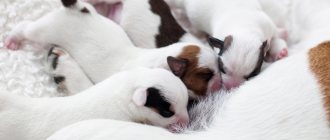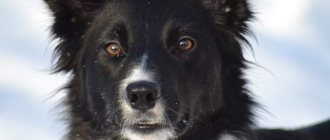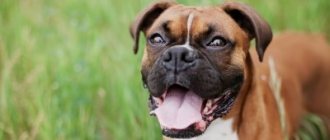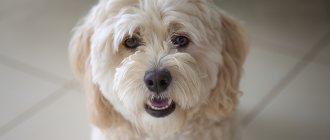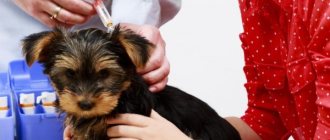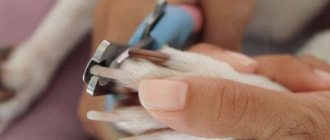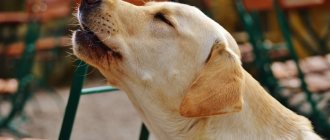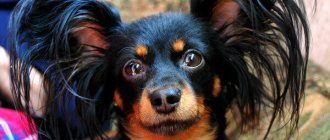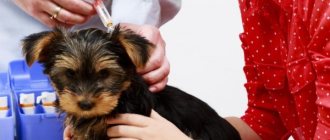Little animal protein
The ancestors of the domestic dog are wild carnivores. This means that it should receive the lion's share of energy from animal proteins. The average protein requirement of an adult dog is at least 4.5–6 grams per kg of body weight per day. To get such a norm, you need to eat mainly meat, meat by-products, fish, and eggs.
But in life we often see a different picture: the basis of dog nutrition is carbohydrates from cereals and grain feed. To bring the protein in feed to the minimum standard, manufacturers use vegetable protein concentrates from soy, wheat and corn. This helps provide nice numbers on the packaging, but provides little benefit to predators. After all, plant protein is absorbed much worse than animal protein and has an inferior amino acid composition.
What is the threat?
- The dog will not receive enough amino acids for the normal functioning of the body and cell renewal, which will lead to loss of muscle mass, decreased immune defense, and deterioration in appearance and well-being.
- Low protein = high carbohydrates, and their excess in a dog’s diet creates excessive stress on the pancreas, contributes to decreased sensitivity to insulin and the development of type 2 diabetes.
What to do?
Use high-quality food that contains at least 50% animal protein sources, and avoid feeding your dog grain-based food.
Do I need to change the brand or flavor of food often?
There is no urgent need to replace the diet, and too frequent replacement can be dangerous due to undesirable reactions from the gastrointestinal tract. Despite this, periodic changes are quite acceptable.
Most four-legged animals sooner or later go on strike and begin to act up because of the boring taste. In such cases, it is permissible to try something new within the same company. Changing the taste of chicken to fish or meat will ultimately only change the main source of protein. The composition formula will remain the same.
For chronic diseases, the system is slightly different. The therapeutic diet involves only 1 version of granules, so in this case the manufacturer will have to be changed. That is, a dog eating food with ICD needs to choose exactly the same one from another company.
Suboptimal amount of fat in the diet
Fat is no less important in a dog's diet. It is a highly concentrated source of energy, a transport medium for fat-soluble vitamins A, D, E, K, and a supplier of essential fatty acids Omega-3 and Omega-6.
How much fat a particular animal needs depends on its activity, age and other individual characteristics. On average, the fat requirement of adult dogs is at least 1–2 g per kg of body weight per day.
It is important to remember that 1 gram of fat provides as much as 9 kcal (unlike proteins and carbohydrates, which provide approximately 4 kcal each), so the principle “the more the merrier” does not work here. A sporting or service dog is not afraid of a high percentage of fat in the diet, while a sedentary and overweight dog should use food with a reduced content of this component.
What is the threat?
- Food that is too fatty can cause digestive problems in the animal and worsen chronic diseases.
- Excess fat = calorie surplus. Over time, this will make itself felt with extra pounds and illnesses.
- A lack of fat also leads to malfunctions in the body: developmental delays, infertility, vitamin deficiencies, skin problems, and deterioration of coat. Low-fat diets are especially dangerous during growth, pregnancy and lactation.
What to do?
You cannot completely deprive your dog of fat, but it is important to monitor the amount. In good quality industrial food, all macronutrients are already balanced in accordance with the biological needs of dogs. If you create your pet’s diet yourself, avoid meats that are too fatty.
Consequences of not drinking
If your dog is eating but not getting enough water, this can lead to a number of serious problems. Possible consequences:
- decreased activity, lethargy and lethargy;
- change in skin tone;
- deterioration of joint function, pain when walking;
- disruption of the functioning of all internal organs;
- slowing down metabolism;
- departure against the background of stagnation of toxins in the body;
- development of chronic diseases.
A prolonged absence of water leads to severe exhaustion of the animal. If the necessary measures are not taken in time, this can result in death. This is why it is important to respond to signs of dehydration as quickly as possible, especially if you have an older dog.
Violation of daily feeding norms
Some owners feed their pets “on demand” without thinking about any restrictions. In fact, relying on a dog's appetite is a serious mistake. These animals naturally have a dulled sense of satiety: instinct tells them to absorb as much food as possible that is currently available, because in their natural habitat, predator meals are irregular. However, at home, such “food for the belly” is not necessary and can only cause harm.
What is the threat?
- Nausea, vomiting, stomach discomfort, increased gas formation.
- Systematic overeating leads to obesity and related diseases.
- When food is constantly in the bowl, some dogs become capricious, picky and beg for treats.
What to do?
Follow the feeding rate recommended by the product manufacturer. Usually this information is on the back of the packaging. You can also find Acana and Orijen diet tables on the product pages on our website.
If the dog does not touch the food, wait 5-10 minutes and remove the bowl. The next feeding should take place on schedule and in the usual volume.
Why does a dog eat poorly or not eat at all: reasons, what to do
If you're concerned that your dog is eating less than the recommended amount on the bag of food, remember that the values on the bag are only averages. Many perfectly healthy dogs eat 60% to 70% of the amount directed on the package.
Because loss of appetite may be due to a medical condition, it is important to contact your veterinarian if you notice that your pet is refusing to eat. It is especially important to respond promptly to changes in feeding behavior in animals that usually eat with appetite.
Although most dogs can go a couple of days without food without any serious negative consequences, it is best to address the problem as early as possible.
The main reasons why a dog may not eat:
- Changing your usual diet;
- Spoiled food;
- Overfeeding or too many snacks;
- Improper or too long storage of feed;
- Sexual hunting;
- Pregnancy;
- Postpartum period;
- Helminthiases and other parasitoses;
- Diseases of the teeth and oral cavity;
- Infectious diseases;
- Fever;
- Intoxication;
- Pain;
- Nausea and vomiting;
- Diseases of the digestive or urinary system;
- Oncology;
- Inflammatory diseases;
- Reaction to medications;
- Post-vaccination period;
- After general anesthesia.
- Stress.
The dog is not eating and is lethargic
A dog's loss of appetite can be a sign of illness, so it's important to seek help from your veterinarian if you notice a change in your pet's eating habits, especially if your dog usually eats well. It is best to understand the problem as early as possible, since if treatment is not started within the first few days, it can lead to dehydration and worsening of the general condition.
If your pet has lost its appetite and is not feeling well, then first of all you should think about the following reasons for this condition:
- Fever . Just like people, dogs with a body temperature above 40 degrees may refuse food and feel unwell.
- Inflammatory diseases. With inflammatory diseases of an infectious and non-infectious nature, the dog may experience pain and discomfort, while the pet may lie down and not want to sniff even its favorite treat.
- Intoxication . Toxins can enter a dog’s body either from the outside through spoiled food, or form in the body, for example, due to kidney or liver failure.
- Oncology . In the initial stages of cancer, the animal may not show that anything is wrong with it. But as the disease progresses, the owner may notice a refusal to eat, lethargy, and weight loss.
- Post-vaccination period. Reluctance to eat after routine vaccinations is considered normal during the first two days after the injection.
- Postoperative period. Within 24 hours after surgery, the anesthesia completely leaves the dog’s body. As a result, your pet may feel unwell and be reluctant to eat.
In all cases, except the last two, it is recommended not to delay visiting the veterinary clinic.
Doesn't eat well but is active
It also happens that a pet is outwardly alert and active, but does not want to eat at all or does it with great reluctance. The reason may lie in the following:
- Stress . The character of dogs differs significantly. Some people have a hard time being separated from their owner, others are dissatisfied with the renovations or the appearance of strangers in the house. All this can cause stress in the dog, causing it to refuse food. However, if the trigger is removed, the pet will return to its normal self.
- Changing your usual diet . Dogs get used to their constant diet and do not always want something new. For this reason, the transition from one type of feeding and type of food to another should be slow.
- Spoiled food . The bag of food should be stored closed for no more than two months. It is better to prepare a homemade diet immediately before serving, and store the food in the refrigerator.
- Overfeeding or too many snacks. If your dog refuses food but still willingly eats treats, try giving up treats for a while.
- Sexual hunting . Bitches during heat may refuse food for a couple of days at most; if the dog is lethargic, then you should consult a doctor. Intact male dogs lose their appetite when they sense a female in heat nearby.
- Pregnancy . Food intake during pregnancy can change both up and down. Carefully monitor the condition of the dog and the fetus.
- Helminthiases and other parasitoses . Depending on the degree of infestation, the animal may be active or lethargic. First of all, you need to remember how long ago you carried out preventive deworming.
- Diseases of the teeth and oral cavity . Most dogs are very patient and do not show toothache. Keep an eye on your pet's oral health by having its teeth cleaned and examined by a dentist every 6-12 months.
- Reaction to medications. With some medications, your dog may still be active but refuse to eat. This is a reason to contact your doctor, adjust the dose of the medication or replace it.
The dog doesn't eat, only drinks.
There is also a situation where the dog does not eat, but actively drinks water. This most often occurs when:
- Hot weather outside.
- Within 24 hours after birth.
- In case of intoxication.
- With purulent inflammation of the uterus - pyometra.
Your task as the owner is to find out the reason and, if necessary, consult a specialist.
Incorrect dog feeding schedule
Another common mistake is the lack of a clear feeding schedule or linking it to your own meals: the dog is fed before the walk, then after, sometimes twice a day, and at times all four.
What is the threat?
- Active walking after a heavy meal increases the risk of gastric volvulus. Representatives of large and giant breeds are especially prone to developing this pathology.
- A dog accustomed to eating with its owner will beg and interfere with his meal.
What to do?
It is better for healthy adult dogs to eat on a schedule - twice a day with an interval of 10-12 hours. For example, at 8.00 and 20.00. It is important to plan feeding after a walk and a short rest.
When the owners are eating, it is better not to let the dog into the room.
Treats and food from the human table
Most dog breeders know that feeding a dog from the table is not recommended. But it’s difficult to resist pitiful glances, so a couple of times during the day your pet will definitely get a tasty morsel. And if there are several compassionate family members, the dog’s life turns into an endless meal.
What is the threat?
- Imbalance of substances in the diet, excess salt, excess of the body's energy needs.
- Poisoning, abdominal pain, stool upset.
- Formation of undesirable eating habits, including complete refusal of dry food.
What to do?
Use only meat treats and try to keep their share to no more than 10% of the daily diet. Under no circumstances feed your dog food that is harmful to it: sweets (especially chocolate), baked goods, salty and smoked foods, avocados, mushrooms, nuts.

